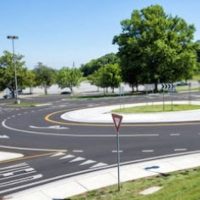Roundabouts: A New, Safer Way Of Handling Traffic?

Have you ever come up to an intersection expecting to see a traffic signal, or at least, a stop sign, and much to your surprise, it’s not there? Instead, in its place, the road curves around in a circle, with roads that branch off from the interior circle. That’s called a roundabout, and although it is not common, it may actually be a safer way of managing traffic than the traditional traffic signal controlled intersection.
What’s a Roundabout?
In a roundabout, traffic from multiple directions converges in one circle. All traffic is routed to the right, and there are “exits” off the roundabout to the other, intersecting streets. Cars seeking to enter the roundabout must stop and merge with the traffic inside the roundabout.
Although this may seem counterintuitive, and perhaps more dangerous than traditional intersections, it actually has proven to be safer. Studies have found that where intersections replace traffic signals with roundabouts, accidents tend to decrease.
Why Safer?
Some studies have found that roundabouts lower fatal traffic accidents by 90%. Why is a roundabout potentially safer? There are a number of reasons.
One obvious reason is that in a roundabout, all traffic flows in the same direction. There is no risk of being “T-boned,” or hit by traffic coming in the opposite direction. There simply are fewer “conflict points”–points where cars can collide.
And, of course, there are no traffic lights or stop signs that can potentially be missed or ignored. In fact, even the most distracted driver can often see the change in the roadway, even if that driver would have normally missed a traffic signal.
Additionally, while traffic signals need power, and go down when the power goes down, roundabouts don’t require any power source, making them safer even in bad weather conditions.
Speed is always a huge factor in accidents, and their severity, and to that extent, roundabouts win again: people necessarily have to slow their cars to navigate a circular roundabout. Drivers who slow down in roundabouts have to remain slow, as the road they are trying to get on or continue on is coming up. The slower speed means lower impacts when collisions do happen, and thus, less severe injuries. That includes impact to pedestrians, who may face better in lower speed collisions.
More Efficient?
As if safety isn’t a big enough benefit, roundabouts actually handle traffic more efficiently; when cars don’t have to stop for traffic lights, traffic moves much faster (even though cars do slow down when approaching the roundabout).
The one drawback to roundabouts isn’t safety—it’s space. A roundabout requires more space to build than an intersection, and in bust urban areas, that space may simply not be available. However, with enough space, roundabouts are quite versatile, and can be constructed to fit lower or high volume intersections.
Intersection accidents can cause serious injuries. We can help. Call the Boston personal injury lawyers today at The Law Office of Joseph Linnehan, Jr. at 617-275-4200 for help with your personal injury case.
Sources:
wsdot.wa.gov/Safety/roundabouts/benefits.htm
iihs.org/iihs/topics/t/roundabouts/qanda
wimp.com/mythbusters-four-way-stop-vs-roundabout/
reason.org/commentary/should-we-stop-worrying-and-learn-to-love-the-roundabouts/#:~:text=The%20Florida%20Department%20of%20Transportation,for%20beginner%20and%20elderly%20drivers
